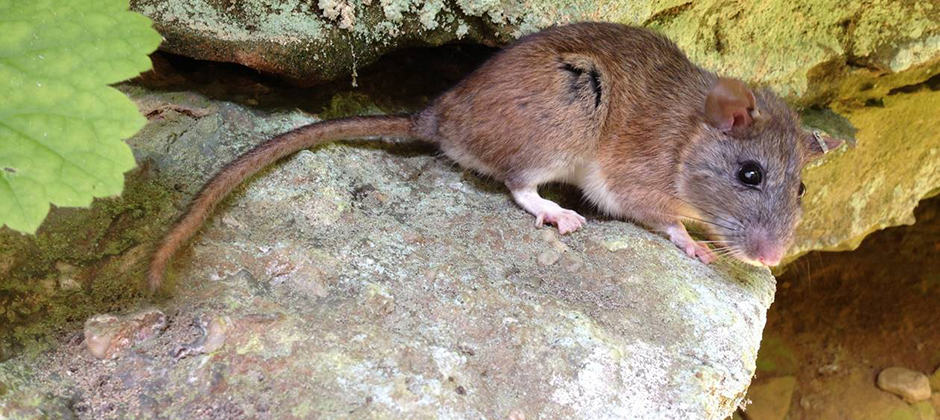Share this article
Rock crevices help relocated woodrats succeed
The best predictor for relocated eastern woodrats to succeed in Illinois is the presence of plenty of rocky crevices for them to nest in.
Eastern woodrat (Neotoma floridana) populations began declining in most of their southern Illinois range between 1925 and 1950. Researchers noticed their declines in the remnant populations in the 1970s, and their population dropped drastically in the late 1990s, when there were just a few remnant populations along the bluffs of the Mississippi River floodplain in the southwest portion of Illinois.
The Indiana Department of Natural Resources developed a recovery plan for the species. That included reintroducing woodrats—often known as packrats—to areas where they had been extirpated and augmenting existing woodrat populations to ensure higher genetic variability.
Between 2003 and 2009, biologists captured woodrats in Missouri and Arkansas and released them into Shawnee National Forest in southeastern Illinois, where there were plenty of rocky outcrops. Since then, monitoring has shown these populations have been doing pretty well. “Most of the places they had been reintroduced, we continued to detect woodrats,” said TWS member Eric Schauber, director of the Illinois Natural History Survey at the University of Illinois Urbana-Champaign’s Prairie Research Institute. By 2020, woodrats met the state’s recovery criteria and were delisted in Illinois.
But researchers wondered why some populations were doing better than others. If they could understand that, they hoped they might also get some insight into why woodrat numbers had been declining in the first place, since they didn’t have active monitoring back then.
Schauber’s doctoral student Aaron Gooley led a study published in the Journal of Mammalogy in which he and Schauber tried to find out why some populations were doing better than others. “The [Illinois woodrat project] was really interesting because it had all the different aspects of some of the higher profile wildlife issues or projects around the country,” said Gooley, a TWS member who is now an assistant professor at the Indiana State University. “It had translocation and genetically augmenting remnant populations, similar to the Florida panther issue.”
They trapped the woodrats and took note of factors that could affect their survival. Were mast-producing trees available to provide food? Were there plenty of rock crevices to offer places for dens? Were there predators—particularly owls—that might eat them? Were they threatened by disease?
Woodrats famously cache objects in their dens, including other animals’ feces that contain seeds. Raccoon feces, however, can also contain raccoon roundworms, which carry a disease fatal to woodrats. “In a lot of cases, good woodrat dens are hard to come by,” Schauber said. “Once one dies, another moves in and starts using that same food cache. It acts like a tar pit for woodrats. They keep moving in and dying.”
But the team found no evidence of raccoon roundworm after collecting and analyzing fecal samples, and while they found plenty of owls after playing owl calls in the evenings, the raptors didn’t seem to limit woodrat populations. It was exciting to be in the dark,” Gooley said. You never know what critters will show up. But if you annoy the owls enough, you can hear them hooting and see them swooping in the sky above you, which is exciting.” The researchers also found no relationship between the number of mast-producing trees and woodrats.
“That left crevices,” Schauber said. That’s where they found a strong correlation. “That availability of habitat at den sites appears to be the primary predictor of success,” he said.
Understanding that can help future reintroductions, Schauber said. And Gooley said that while woodrats may not necessarily need rocky outcrops, the findings suggest eastern woodrats as well as similar species like the Allegheny woodrat (Neotoma magister) need stable structure to persist. “I wonder if using downed woody debris is a way to create additional woodrat habitat as well as help connect woodrat populations as a means for population management and recovery,” Gooley said.
But the findings still leave woodrats’ initial decline a mystery. Schauber suspects it may have something to do with their forests being cleared between 1860 and 1940. Gooley also believes that deforestation as well as farmer persecution of the woodrats could have played a role.
Meanwhile, things are looking up for the woodrat. After the initial reintroduction effort, woodrats have been released in two other state parks located between the previously reintroduced population and remnant populations. “Those appear to be successful as well,” Schauber said. “Given that we are starting to see woodrats spread into the landscape away from reintroduction sites, it’s possible to have one contiguous population across southern Illinois.”
Header Image: Eastern woodrat reintroductions have been successful in southern Illinois. Credit: Aaron Gooley








